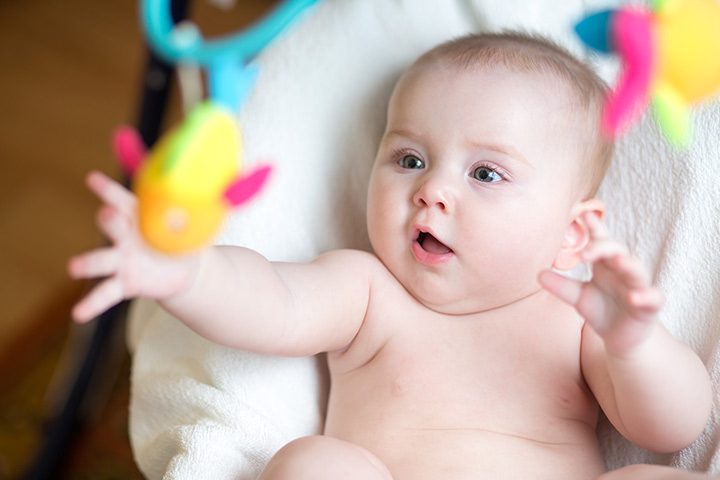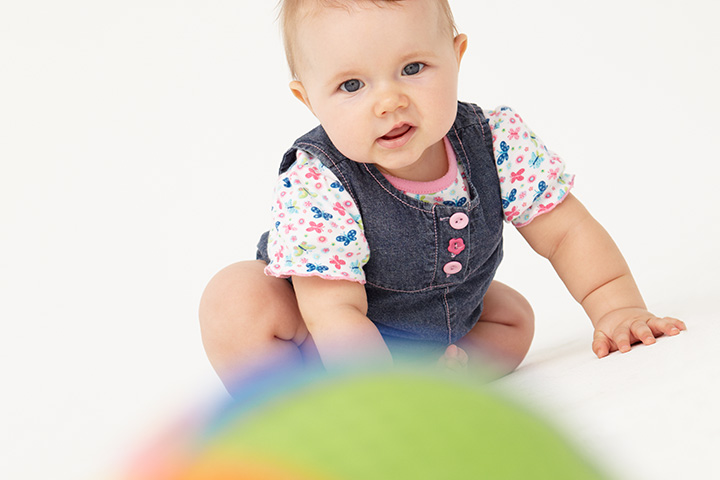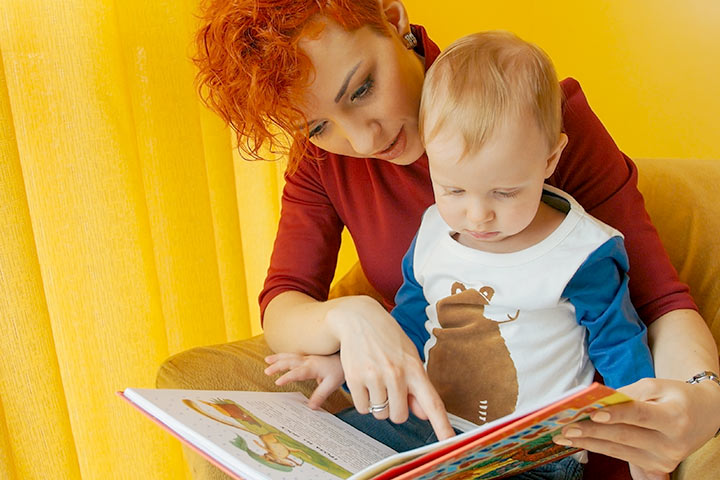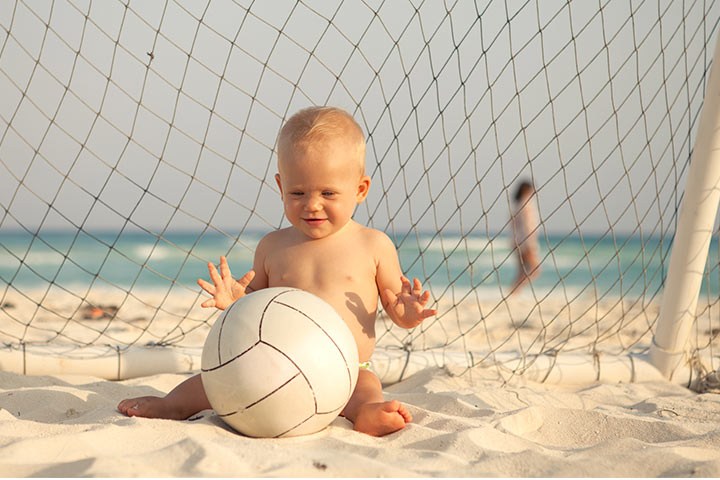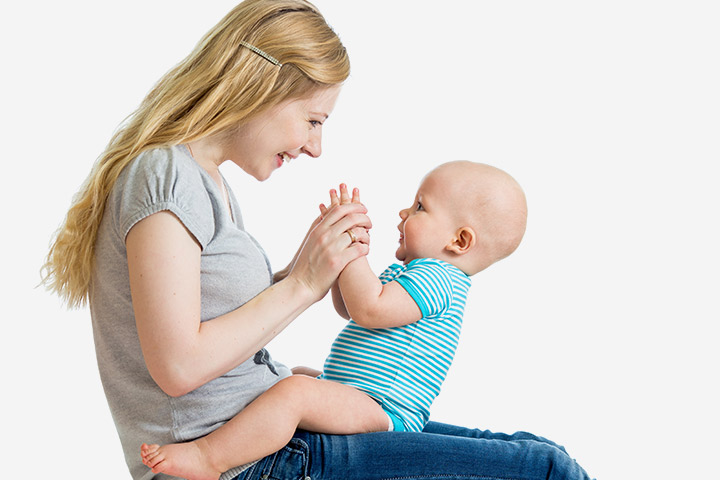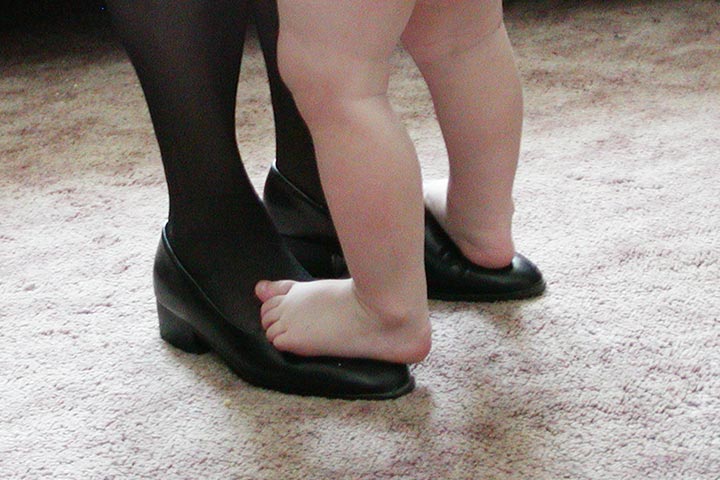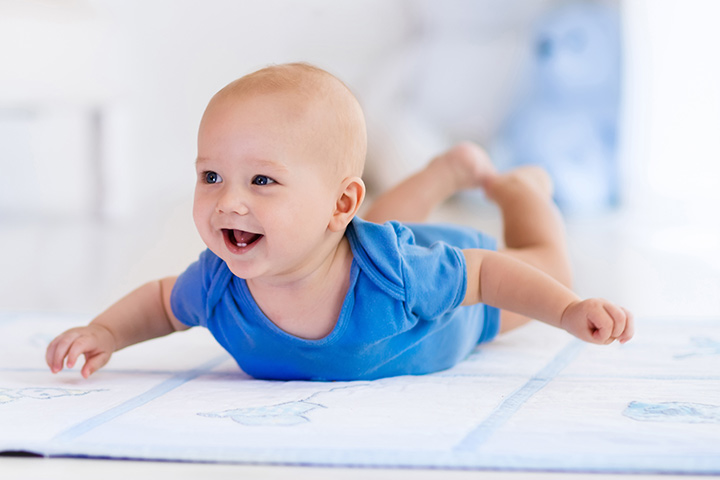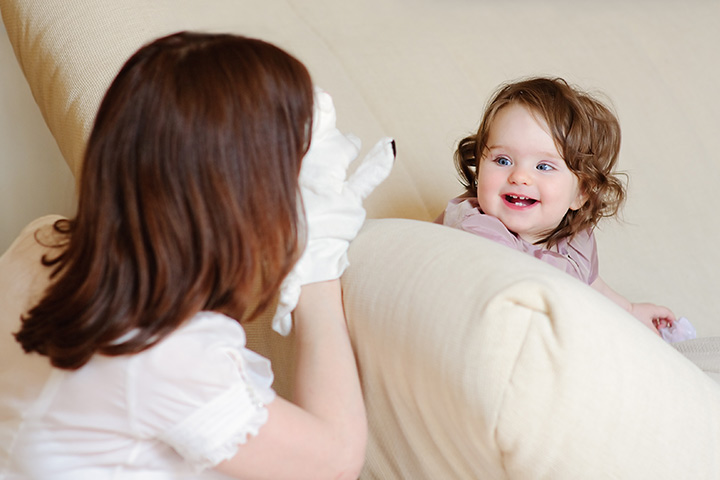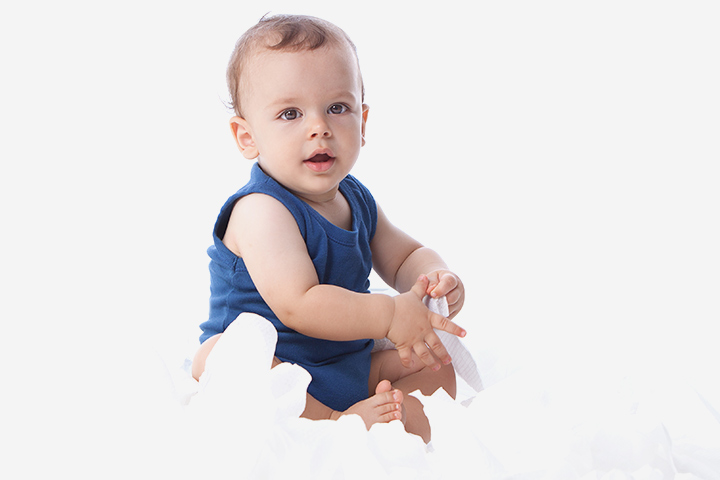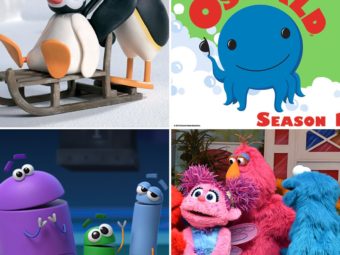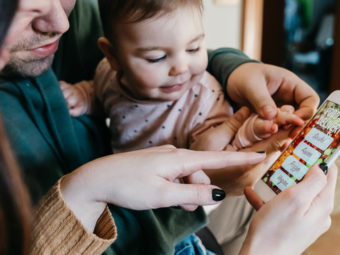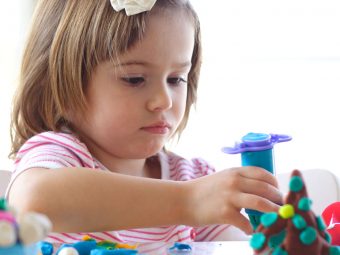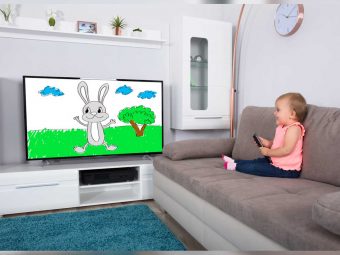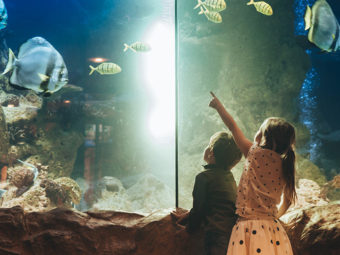
Image: ShutterStock
Watching your baby grow is amazing and fulfilling. As your baby nears their half-year birthday mark, you may want to know about the activities for 5-month-olds. The developmental milestones for 5-month-old babies are also significant and should be noted.
At this age, their conversations are mostly gibberish and filled with smiles and baba-gagas. They also begin to express emotions such as joy, happiness, and sadness. Additionally, a study revealed that 5-month-old babies could move their bodies better than before (1). This is also the time when you can start engaging them more in playtime activities, which also aid in their development.
Keep reading to learn about some of the milestones to look out for in your little one at five months.
Key Developmental Milestones For 5-Month-Old
Knowing the milestones will help you choose the right activities and games for your 5-month-old baby:
- Greater muscle dexterity: Your baby will be able to grasp light objects and move them around. He will also try to hold his feeding bottle.
- Better visual perception: A five-month-old can recognize familiar faces as well as his personal objects such as the cradle and toys. He will be able to track moving objects with his eyes and make eye contact with people.
- Finer judgment of sounds: Your baby will turn and point his head toward the source of a sound; he/she may also try to imitate the sound or respond with a coo. He will also recognize familiar voices, such as those of people over the phone, and the sounds emanating from his favorite toys.
- Improved cognitive abilities: The baby will show the ability to do things independently like rattle objects to understand their purpose. He will also show a wider range of facial expressions that will differ according to the situation and the person he is interacting with.
17 Games And Activities For 5-month-old Baby
No more nerve-racking on how to play with a 5-month-old baby. Here are some great activities you can engage in:
1. Bubble Play
What you will need: Bubble making toy
How to: Bubbles are a great way of capturing your baby’s attention. You and your partner can blow bubbles together in a way they float close to your little one. If he shows signs of excitement by laughing and moving his hands increase the bubble flow.
Skills developed: Visual and sensory skills
 Did you know?
Did you know?2. Find The Missing Object
What you will need: Blanket and the baby’s favorite toy
How to: Lie the baby on the bed, which has a blanket on it. Take your baby’s favorite toy which he recognizes well. Place it half-hidden under the blanket with just the edge sticking out. Prompt the baby to pick the toy and when he tries to reach for it, slowly pull it underneath the blanket. Do it slowly till the baby tugs on it and shows an expression of curiosity. Let the baby pull the toy after some tugging. Once the baby gets it, repeat the game with other items.
Skills developed: Fine motor skills and curiosity
3. Source Of The Sound
What you will need: A Rattle and a cloth
How to: Hold the rattle and ring it close to the baby making sure it is not too close to his ears. Once you have your little one’s attention, slowly hide the rattle behind a towel or a piece of cloth. Keep rattling the toy and move the cloth around while observing whether or not the baby follows the source of the sound. If your baby is lying down, hold the rattle 20 cm above his head and shake it gently. If he tries to look up, move the rattle away from his line of sight while ringing it. Observe if he tries to rotate his head to the source of the sound. You can also plan an elaborate version of this activity where you can hold your baby while your partner rattles the toy behind a pillar or a door.
Skills developed: Auditory skills, visual interpretation, cognitive abilities, muscle-eye-ear coordination
Ashley, a mother of two girls, shows her four-month-old daughter Miya playing with and exploring a rattle toy in her Montessori activities video. Narrating her daughter’s curiosity-filled play, Ashley says, “What she’s able to do with it is use her fingers to grab on to all the little wooden dowels in the middle and just shake it like crazy. She’s starting to learn about cause and effect, what happens when I grab onto this toy and move my arm, and I can tell that it’s very exciting for her because she gets very exuberant about her rattle shaking once she realizes what’s happening (i).”
4. Track The Toy
What you will need: A soft toy, a long string, your partner
How to: This is a simple game to capture the attention of your baby when he is having a meltdown or just being fussy. Sit on a floor rug while holding your baby in a sitting position. Tie his favorite soft toy to a long string and hand it over to your partner. Ask your partner to move the stringed toy around on the floor slowly so that the baby can see it. Watch your baby’s reaction and when he seems interested prompt him to grab the moving item by giving word cues like “Oh, what’s that?” Increase the speed if you feel the baby is transfixed and is moving his gaze with the toy.
Skills developed: Visual perception and muscle-eye coordination
5. Story Time
What you will need: Colorfully illustrated children’s book
How to: This is a great bedtime and learning activity for 5 month olds. Hold him in your lap with the open book right in front of him. Read the story aloud while pointing towards the brightly colored illustrations. Let the baby hold the book if he does, and in case he turns a page read from the page he just opened. Add some funny sound effects such as “Boom” and “Yippee” that are bound to make him giggle. The idea here is to make him familiar with basic words and their corresponding images.
Skills developed: Language and phonetic skills, color perception, cognitive abilities
 Quick tip
Quick tip6. The Toy Box
What you will need: Container with a small opening at the top
How to: Take a plastic container, with no sharp edges and fill it with small toys that your baby plays with regularly. Bring the container close to the baby and tilt it in a way that some toys fall off it. Repeat it twice or thrice and hand the container to your baby encouraging him to tilt and move the box. Appreciate him with some encouraging words every time he slides a toy out of the box. Let him shake and rattle the box if he does so and perhaps you can add to the clatter!
Skills developed: Logic and reasoning, motor skills
7. Bouncing Ball
What you will need: Soft and squishy bouncing beach ball
How to: A great fun outdoor game for your 5-month-old that is simple and easy. Take the soft ball and roll it around a lawn while also making it bounce. Once you have his attention, bounce the ball and then gently throw it towards him. Motivate him to grab the ball and if he does, ask him to push it over towards you. He may crawl around with the ball. Encourage him to do so by standing at a distance and asking him to crawl with the rolling ball towards you.
Skills developed: Gross motor skills, social play, curiosity
8. Junior Sit-ups Workout
What you will need: You and your baby
How to: Sit on a bed with your legs stretched out. Place a soft towel on your thighs, and lie your baby on it. Hold him under his arms, and slowly raise your knees to bring his face close to yours. Keep singing a rhyme or do some baby-talk every time you bring him close to you. Straighten your legs thereafter and repeat the exercise. In case your baby has a good head support you can lift without flexing your legs.
Skills developed: Social bonding skills, head muscles control
9. Peek-A-Boo
What you will need: A curtain or a door, your partner
How to: Ask your partner to hold the baby while you hide behind the curtain. When the little one sees you doing that say something from behind the curtain to grab his attention. Then suddenly appear from a corner of the curtain with an exclamatory sound – “Boo!”. Repeat it while making it a point that you come out of the curtain at different time intervals and from different points. You can also play the game by opening and closing the door instead of being in a curtain.
Skills developed: Visual perception, social bonding, voice recognition
10. Music And Dance
What you will need: Different types of music, a soft floor rug or bed
How to: It is a great way of developing your baby’s motor skills and locomotion. Play peppy music that may entertain your baby. Keep the volume within comfortable limits. Hold your little one underneath his arms and rock him on the rug or a bed. If he tries making a movement, help him do so. You can also make him sit in your lap and move his arms to the rhythm of the music. Feel free to add your own sound effects and lyrics to the melody.
Skills developed: Motor Skills, listening, social play
11. Tummy Time Fun
What you will need: A rug or bed, your baby’s favorite toys
How to: Put your baby flat on his tummy on a soft rug or on the bed. First, notice if he seems comfortable in this position, then place all his favorite toys in front of him and let him play with them while you keep a watch. This playtime on tummy helps strengthen his back and neck muscles, which eventually help the baby walk and rotate his neck. You can also ask your partner to stand at a distance and call out the baby’s name. See whether he tilts his head upwards to look. This will help improve his control on the neck muscles. Always remember to be by the side of the baby to prevent him from accidentally rolling into an uncomfortable position. Also never play the game when he has just been fed since pressure on the belly can cause an acid reflux. Play the game as long as the baby seems to be in comfort, and if he shows signs of discomfort or tries to roll over, put him back in a normal position.
Skills developed: Muscle strength and conditioning, neck-eye coordination
 Quick tip
Quick tip12. Hand Puppet Fun
What you will need: A cute hand puppet
How to: This is a great way of bringing a level of interaction in your baby’s play time. Glove your hand in a hand puppet and move it close to your baby while making funny sounds. Encourage him to touch the puppet and run his hands over it. Give him positive feedback through the puppet every time he gets his grip right.
Skills developed: Fine motor skills, sense of humor, imaginary skills
13. Smell And Fragrances
What you will need: Fruits and vegetables
How to: This is one of the stimulating activities for a 5 month old baby. Lay down some cut fruits and vegetables close by.Hold your baby and bring each bit of the food item at a distance of 10cm from his nose and let him sniff at them. Give him ample time to sense the fragrance and observe his reaction. You can use fruits and vegetables that have distinct pleasant fragrances such as mangoes, bananas, and carrots. Do not use those with sharp or pungent smells such as onions and citrus fruits. Also, make sure the food items are washed and neatly chopped. If your little one shows interest in holding a food item, let him do so but do not let him eat any since he is too young for it. If he accidentally licks at something it is okay since it is not going to harm him. Though, do be careful about not having fruits or vegetables which are common allergens. This activity is a great way of sharpening his sense of smell, which is as important as other sensory perceptions.
Skills developed: Sense of smell, ability to associate smells with objects
14. Water Toys
What you will need: Bathtub, water squirting toy
How to: This is a great bath time and one of the fun activities for 5-month-old baby. While he is soaking in water, bring a squirt toy and squirt some water around him. Do so repeatedly till he focuses his attention on the source of the water, which is the nozzle of the toy. Once he seems interested, hand him the toy and let him play with it. Ensure that he does not put it in his mouth and does not point the nozzle towards his face. Every time he squirts water, exclaim a sound. This will help him associate the sound with the toy and he might just babble the word by himself every time he sees his toy.
Skills developed: Visual perception, object-sound association, social play
15. Lights In The Boxes
What you will need: Colorful plastic containers, small flashlight
How to: Switch-on the flashlight and place it inside the container and close the lid tightly. Ensure that the container is of ample thickness to subdue the sharpness of direct light. Once done, switch-off the lights and put the containers in front of your baby. Since it is dark, he will focus on the glowing boxes. Slide the boxes in front of him and encourage him to explore them on his own. Refer each box by its color since that will help him associate the box with a word.
Skills developed: Color-object association, night time vision
16. Paper Towel Rings
What you will need: Paper towel or tissue paper rings
How to: Tear some paper towel or tissue papers and roll them into rings of the diameter of your baby’s arm. Take these rings and slide them gently over the baby’s hands like bangles while ensuring he sees what you are doing. Once done, ask him what those are and play with them while they are still in his hands. Encourage him to touch and feel them with his other hands and if tries to remove them let him do so. Try this activity regularly while slowly letting him wear those rings on his will.
Skills developed: Fine motor skills, object perception, sense of touch
17. Kick The Toy
What you will need: A string, a soft toy, and a floor rug
How to: Tie a soft toy by the end of a string and suspend it from the base of a chair or slide it between the cushions of the sofa such that the toy dangles below. Lie your baby on the floor rug in a manner that his feet touch the soft toy. Gently pat the toy to the sole of his feet and prompt him to kick the toy. Every time he hits the toy utter a word of appreciation. You can even try this activity with his hands.
Skills developed: Gross motor skills, sense of touch, sense of fun
Those were some amazing activities to boost the growth and development of your baby. These will also help sharpen his sensory reflexes, which in turn will improve his overall personality development. What’s more, get ready to engage your 5 month old baby.
7 Bonus Tips For Parents Of 5-month-olds!
Raising a baby is surely a full-time job. The amount of attention and care the little one demands can, at times, be overwhelming. But when you eventually hear his gurgles and see his lopsided smile, everything just becomes worth the effort. Here are some tips for better parenting.
- Babies have personalities and just like adults they can have mood swings. Respect your baby’s demeanor and never force him to do something especially when he is visibly distressed.
- A baby can take his time to interpret and learn an activity. Do not feel disheartened or panic if your five-month-old is unable to play a game in one go. It is possible that he is perhaps figuring out things before learning them by-heart.
- Baby-proof your house by covering all the pointy edges, putting sharp objects away, and locking the cupboards that could be accessible to your little one. Once you are all set, encourage your baby to crawl and explore the house. Keep a watch and prompt him whenever he finds something interesting.
- Your bundle of joy is now transforming into a bundle of energy – moving his hands and feet with vigor. Remove all the toy hangings and drooping items attached to the top of the crib as they can get entangled to your baby’s arms and legs
- Your baby will love putting things in his mouth since that is how he explores the world. Babies have finer control over their lips and tongue than their hands and feet. Also, they have more nerve endings in their mouth than elsewhere, making them more likely to put objects in their mouth to taste them. So, let him discover the world through their tiny mouths. Just keep in mind that you choose toys that are specially made for the purpose of gnawing such as teething toys for babies. Be watchful whenever he puts a toy in his mouth. Ensure though that you clean these toys regularly to prevent an accumulation of bacteria that could be harmful to your baby.
- Talk to your baby as much as you can. Babies pick up languages and their nuances from their parents and try to mimic them.
- Hold, cuddle, and kiss those potato cheeks! Babies love the feel of touch, especially from the mother. It gives them a sense of security and soothes them. But at the same time let your baby interact with others such as friends and family members. Human beings are social animals and the more faces he sees the better he would be at his social bonding skills.
Frequently Asked Questions
1. How often should I read to my 5-month-old?
You can create a routine where you read to your baby regularly at the same time. Read at least once daily so your child gets habituated and enjoys it too.
2. Can I start teaching my 5-month-old basic sign language?
A baby can be taught basic sign language between six and nine months of age. It is the phase when the baby can use basic signs and gestures to express their needs (2). You may introduce basic signs and gestures associated with different needs to your five-month-old. It will make for an early start.
Activities for 5-month-old babies should aim to stimulate their developmental milestones such as rolling, babbling, or mouthing various objects. Bubble play, looking in the direction of the sound, tracking the toy, sit-ups, peek-A-boo, etc., stimulate the baby’s senses. Providing tummy time fun can be exciting if your baby begins to hold their head up, which also benefits from easing problems. You may attach some colorful and sound-making toys to their cribs since they can kick the toy and have fun when bored. You may also talk to them and wait for their response in babbling while playing.
Infographic: Developmental Milestones For 5-Month-Olds
Once your baby reaches the fifth month, interaction with them may be more fun since they are much more aware and curious than before. So if your baby is about to enter their fifth month, this infographic will help you track their progress by understanding the important milestones. Illustration: Momjunction Design Team
Key Pointers
- Engage your 5-month-old baby with stimulating objects and activities in a lively environment.
- Introduce colors, textures, and sounds to your baby through activities such as playing with bubbles, reading books, and musical play.
- Help your baby develop fine motor skills by letting them pick up toys, play with a ball, and use paper towels.
- Bond with your baby through singing songs, playing games, and cuddling.
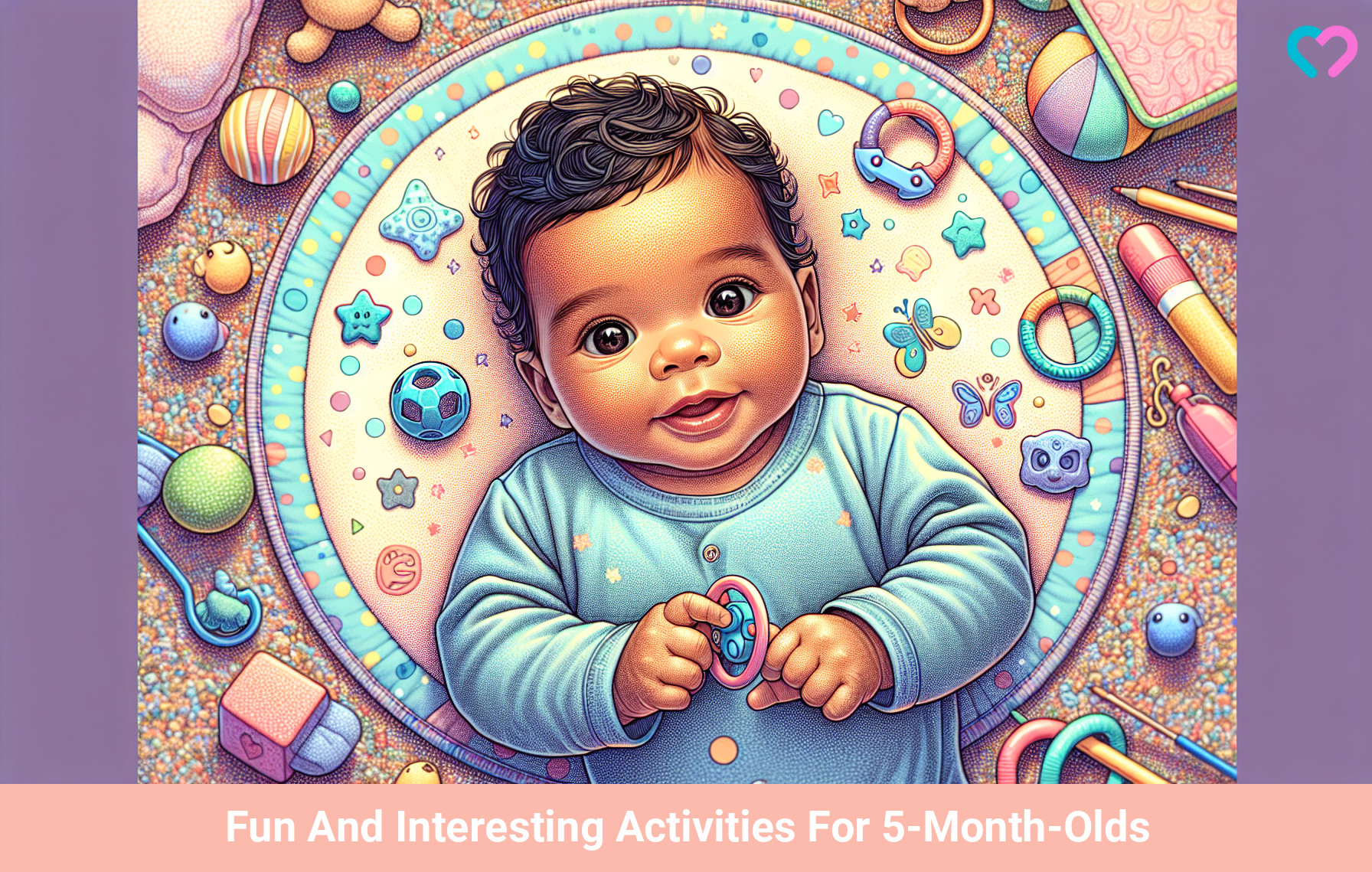
Image: Dall·E/MomJunction Design Team
Personal Experience: Source
MomJunction articles include first-hand experiences to provide you with better insights through real-life narratives. Here are the sources of personal accounts referenced in this article.
i. Montessori at home: activities for babies 3-6 months.https://www.youtube.com/watch?v=Y_8nlwkioLw
References
- 5-6 months: baby development.
https://raisingchildren.net.au/babies/development/development-tracker-3-12-months/5-6-months - Baby sign language: A helpful communication tool.
https://www.canr.msu.edu/news/baby_sign_language_a_helpful_communication_tool







